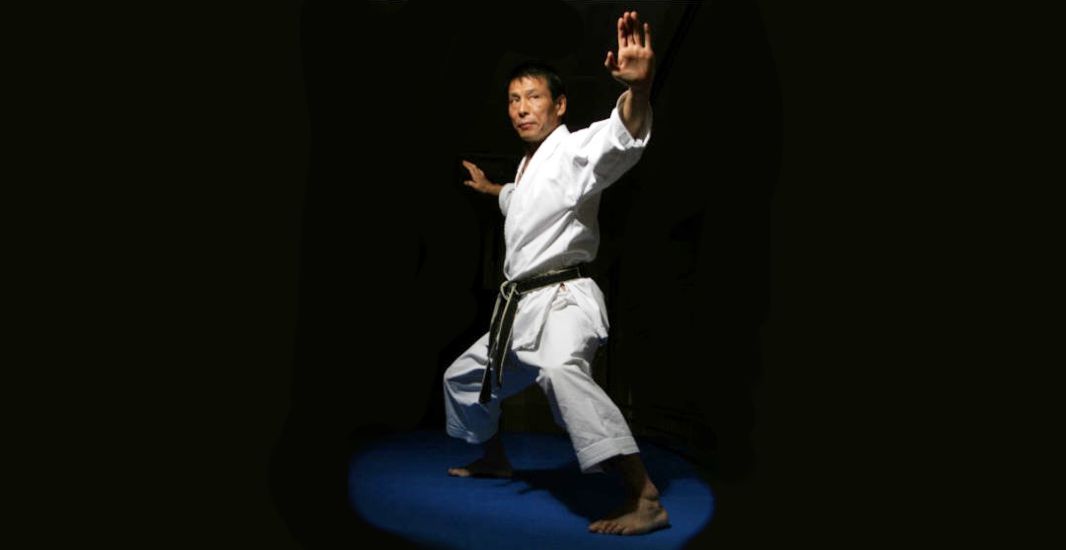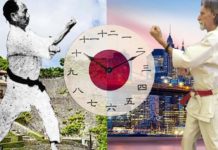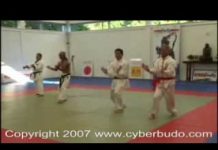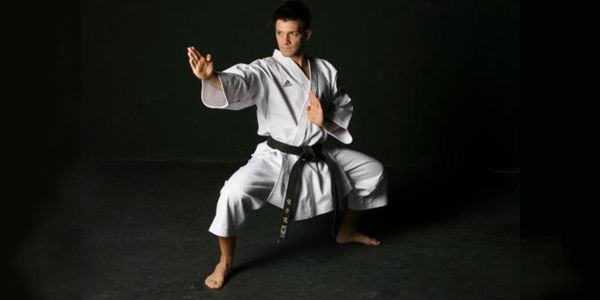
Although they are often derided by the uninitiated for their perceived lack of practicality, the katas are the key to ensuring karate remains a relevant and functional system.
Karate is most commonly practiced as a mid- to long-range kicking and punching system. And whilst karate practitioners tend to be very skilled at impacting at this range, they are often found wanting should the fight go to close-range. This is because most modern dojos do not include close-range striking and fundamental grappling skills in their training. A chain is only ever as strong as its weakest link and it is this lack of close-range skills that could be the karateka’s undoing in a live situation.
In modern dojo and competitive sparring, karateka tend to fight exclusively at mid- to long-range, and this is why this close-range ‘skill gap’ (no pun intended) is not readily apparent. However, if the karateka should engage in any-range sparring, it will quickly become obvious that the practically biased karateka needs to ensure their training regime includes all ranges of combat.
Karate itself does not lack close-range skills, but the prevailing modern interpretation certainly does. Modern karateka – and practitioners of most other modern arts for that matter – tend to focus on the skills needed to defeat a practitioner of their own art in a way that is consistent with competitive rules. Boxers train to defeat boxers, judoka train to defeat judoka, wrestlers train to defeat wrestlers, and karateka train to defeat other karateka. If training is focused on the defeat of another karateka, who will stay at the range encouraged by modern competitive rules, then the karateka has no need for any close-range skills. However, for self-defence purposes, it should be readily apparent that the chances of you facing another karateka are extremely remote. In a real situation you are most likely to face an untrained assailant (not to be confused with ‘un-skilled’) at close-range. If the whole or part of your training is geared towards self-protection then you definitely need to ensure that you include close-range techniques and methods in your training.
Strictly speaking, karate is not a ‘martial’ art. It was never intended for use in war. Karate was devised by civilians for use in the civilian environment (self-protection). Therefore, the earlier versions of karate must have included the required close-range techniques and methodologies. The earlier versions of karate are recorded within the katas, and hence it is within the katas we need to look if we wish to ensure that we practise karate in its most complete form.
In my books, videos and other articles, I have shown how the movements of the katas can be applied as chokes, strangles, joint-locks, throws etc. When you actively study the katas, as opposed to just practicing them, you are able to reintroduce the close-range methods recorded within the katas back into your training (see my Bunkai-Jutsu book and series of video tapes for guidance on how interpret, understand and apply the katas). Your karate will become more complete and more suited for self-protection. However, even with the techniques of the kata ‘reactivated’, you may still find that some ‘skill gaps’ remain.
As an example of these ‘skill gaps’; when I first started examining how the techniques of the kata could be used when fighting on the ground, it quickly became apparent that I needed to be able to control the opponent’s movement in order to apply those techniques. Ground fighting holds are not commonly practised within karate circles, and they are not found within the katas; however, knowledge of them is needed if we are going to be able to apply and vary the techniques of the kata for use on the ground. The solution to my problem was to study the holds and control methods of dedicated grappling arts such as judo and jujutsu and adopt these methods into my karate training.
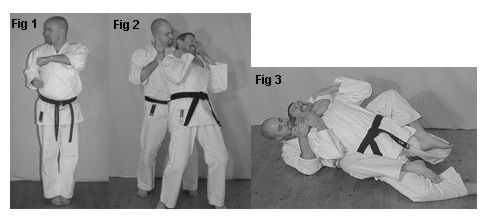
In figure one you can see the third movement of Pinan / Heian Godan (Figure 1). In figure two, we can see the motion being applied as a choking technique (Figure 2). For detailed information on this application see my video ‘Bunkai-Jutsu Volume 1: The Pinan / Heian Series’. To apply the choke from Godan whilst on the ground, I need to be able to control the opponent’s movement from a horizontal position. By adapting the use of ‘The Hooks’ – commonly found in Judo and Jujitsu – into my karate training I am better able to apply the kata technique on the ground (Figure 3). You learn more about these holds in my ‘Karate’s Grappling Methods’ book.
My preferred art has always been karate; however, I count myself lucky that during my twenty-plus years in the martial arts I’ve had the opportunity to learn from practitioners and teachers from many differing systems. If I come across a technique or training methods that I feel will be of benefit to me, I will adapt those methods into my training. I certainly don’t reject them just because they are not ‘karate techniques’! I will use any methods to fill my own ‘skill gaps’, regardless of their origin.
The interesting thing is that on numerous occasions I later noticed that many of these ‘foreign’ techniques were actually present in the katas! I had just failed to previously recognise that the kata movement could be used for that purpose. Geoff Thompson describes the exact same experience in the foreword to my ‘Karate’s Grappling Methods’ book. He wrote, “I spent a year training as a fulltime Judo student under the charismatic Neil Adams. What amazed me even more than the dextrously dangerous (and paradoxically gentle) Mr Adams was how much of the Judo syllabus I recognised (much of it for the very first time) from the karate kata”. Studying the methods of other arts will not only help to fill your ‘skill gaps’, it can also help you to better understand your core art and perhaps bring you to conclude that the ‘gaps’ in karate are not as big as first thought. Karate lacks a lot less than the uninitiated would first suppose when the techniques and methods recorded within the katas are ‘unlocked’. However, no martial art contains all the answers, and karate is no exception.
Some of the techniques and methods needed to close your ‘skill gaps’ will not be found in the katas (e.g. the ground fighting holds I mentioned earlier). It is also a fact that the katas cannot possibly contain every possible strike, choke, throw, joint-lock etc. However, the katas do contain the core principles and concepts upon which all the differing methods are built. In our training and study we should experiment with the techniques and concepts of the katas, and examine how other arts utilise those exact same concepts.
To better explain this idea of techniques vs. concepts, an analogy I like to use is to think of a kata as being like a block of ice. The shape of the block of ice is constant. However, if heat is added, the ice will turn into water and its shape will adapt to fit its circumstances. Likewise, a kata is also constant, but in the heat of combat it will also adapt to its circumstances. The block of ice and the free flowing water may look very different, but they are essentially identical (the same molecules of hydrogen and oxygen). In the same way, a kata may look different to the techniques as applied in the rough and tumble of a live fight, or the techniques found in another art, but they are also essentially identical (the same concepts and principles). In any field of study, an understanding of core principles, and the innumerate ways in which they can be manifested, is infinitely preferable to a superficial understanding of specific techniques.
One of my favourite quotations in the martial arts is that of Hironori Otsuka (founder of Wado-Ryu karate); ‘ It is obvious that these kata must be trained and practised sufficiently, but one must not be ‘stuck’ in them. One must withdraw from the kata to produce forms with no limits or else it becomes useless. It is important to alter the form of the trained kata without hesitation to produce countless other forms of training. Essentially, it is a habit – created over long periods of training. Because it is a habit, it comes to life with no hesitation – by the subconscious mind. ‘ (‘Wado-Ryu karate’ page 19-20). Otsuka is telling us that we should integrate the principles of the forms into our subconscious so that we can freely apply those principles relative to the situation at hand. Again, this emphasises the importance of principles over techniques and tells us that the forms are essentially a record of these key principles.
All fighting techniques are based on the same principles, regardless of the art from which they originate. If we can learn a new variation on the techniques in the katas, or a new way of expressing the core principles, we would be foolish to ignore them just because they come from another art. These ‘extra techniques’ can help us to fill our personal ‘skill gaps’ and ensure that we are able to function at all ranges and in all situations.
Katas essentially exist to fulfil two purposes; to record combative techniques and principles, and to provide a means for an individual to practise those techniques and principles. So if we are to learn ‘non-karate techniques’ to fill any ‘skill gaps’ that remain after we have ‘reactivated’ the techniques of the traditional katas, does that mean we have to create new forms to record these new techniques? There is no reason why you couldn’t create further forms, but in my opinion there is no real need to.
Any ‘new’ technique or method is sure to have plenty in common with the techniques already present in your existing kata. All you need do is ‘mentally attach’ the new technique to that part of the kata. You don’t alter the kata; simply make a mental note of the ‘new variation’ of the kata technique. In the same way that the founders of the katas only recorded specific examples to express core principles, you are simply ‘mentally attaching’ the ‘new technique’ to the kata technique that best demonstrates the principles upon which it is based. This will give you a point of reference and method of recording the technique, which is, after all, one of the key functions of the kata. Whilst it is possible that the founder of the kata may not have been aware of that specific technique, they were aware of the underlying principles and I feel certain they would welcome their kata being used to record these additional methods.
I’m sure there are some who would argue that recording ‘non-traditional’ techniques using a ‘traditional medium’ is not acceptable. However, to my mind the ‘traditional’ function of a kata is to record effective techniques and principles. That is exactly what we are doing on the occasions when we ‘attach’ techniques to the kata that were derived from other sources.
Although I find the history of the various arts extremely interesting, I’m no historian. I’m first and foremost a pragmatist. Whilst some karateka may only be interested in the ‘original’ and historical use of kata, what matters to me as a modern-day pragmatist is how I can make use of the traditional katas to expand, enhance and record my martial skills. If I sometimes interpret and make use of the katas in differing ways to the martial artists of the past, then so be it. We should never place such a heavy emphasis on ‘history’ that any modern-day practical considerations are ignored on the grounds that ‘the kata does not allow that’ ! How the martial artists of the past utilised the katas should never be a barrier to our progress. We should avoid historical dogma and ensure that we remain true to the core tradition of pragmatism. I feel certain that it is this approach that the past masters would wish us to adopt. As Otsuka said, we should not become stuck in the katas, but instead make use of them to produce forms with ‘no limits.’
Traditional katas have a great deal to offer the martial artist, but only when they are correctly understood, practised, expressed and applied. Whilst the prevailing version of modern karate is a high-level mid- to long-range art, the analysis and practise of the techniques and concepts in the katas can help us to reintroduce the ‘forgotten’ close-range aspects back into karate. The study of kata applications will help us to plug any ‘skill gaps’ and will return karate to the potent combative system it once was. We should also endeavour to close any remaining ‘skill gaps’ by looking at the methodologies of other arts, and in particular how they make use of the common combative concepts that form the basis of the katas. Kata can also be a useful way to help us mentally record any additional techniques or methods that we have learnt from other systems.
Although they are often derided by the uninitiated for their perceived lack of practicality, the katas are the key to ensuring karate remains a relevant and functional system. Through an understanding of the techniques and concepts recorded within the katas, we can plug the ‘skill gaps’ that are present in much of modern training and practise karate as a functional self-protection system.


